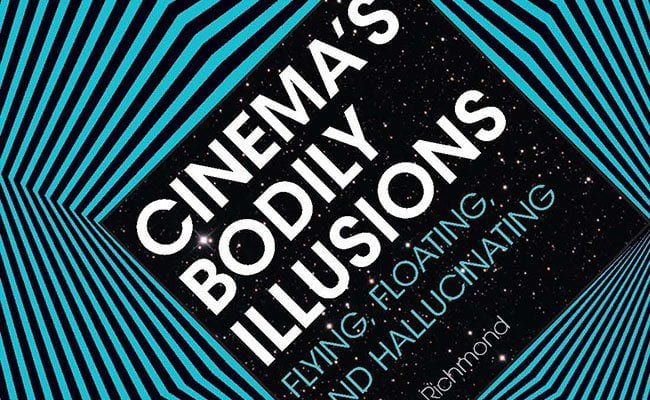
In Cinema’s Bodily Illusions, Scott C. Richmond presents a model of media studies that looks at how the cinema causes our perception to be fooled through the technology and techniques of the cinema. “…(P)roprioceptive aesthetics lies at the heart of the cinema as an aesthetic medium and a technical system,” writes Richmond (6). His methodology is to look at the similar frames of Maurice Merleau-Ponty’s phenomenological approach to perception and James J. Gibson’s ecological approach to perception and understanding. Gibson attributes proprioception as an organism’s “posture and orientation in the world” which is perceived across all senses (7).
In the acknowledgments, Richmond marks the formative moment on a Disney ride that led to his theoretical interests. Following his example, I will try to explain the underlying concept through my own experience. As a child, I saw an IMAX film at The Space and Rocket Center in Huntsville, Alabama. By Richmond’s model, this may have been my first aesthetic experience and it was proprioceptive. In the scene I remember over 30 years later, a camera travels down a zip line in an escape basket an astronaut would use if something went wrong leading up to launch.
The scene disoriented me as much as if I were on a roller coaster: I felt movement and myself traveling through the space of the film. My senses had been modulated by the technology in the IMAX theater. Upon turning away and seeing my arm on the armrest, I realized my perception of my body moving through space had been totally affected by the technique and technology of the cinema. Richmond walks us through many scenes from Alfonso Cuarón’s Gravity (2013), Stanley Kubrick’s 2001: A Space Odyssey (1968), Marcel Duchamp’s Anémic Cinéma (1926), Godfrey Reggio’s Koyaanisqatsi (1982), and Tony Conrad’s The Flicker (1965). He demonstrates both his theory and method in extended and detailed descriptions of the modulation of his perception by the cinematic sequences.
Most chapters offer a discussion of theory which requires the reader to understand theoretical perspectives often used in film and media studies. While Richmond critiques theory and theoretical positions of canonical figures like Laura Mulvey and Louis Althusser, he doesn’t go into great detail, expecting the reader to have a familiarity with them. This also applies to the phenomenological theorists including Merleau-Ponty and Renaud Barbaras and earlier philosophers. Readers with a solid background will be able to follow the arguments presented, but readers who have limited exposure may find Richmond’s main ideas get lost in the intricacies of his argument. This book offers readers a critical and philosophical discussion, so the structure does not detract for the intended audience.
Much of the text requires readers to have a fresh and thorough understanding of modernist film and media theory, as Richmond positions his claims against theory produced by Stanley Cavell, Laura Mulvey, and other theorists engaging with the apparatus model of film criticism. He reinforces the hangups modernism produced on the theory of a body in the cinema by demonstrating the theoretical limitations produced of the symbolic, the representational, and reflexivity. By charting Barbaras’ epochē, he returns the aesthetic experience to the cinema modulating the presence within the technical system. Removing the reflexive and the representational allows the phenomenological study of the self as perception affected by the technical systems and techniques.
While demonstrating how both Merleau-Ponty and Gibson had similar influences, Richmond demonstrates Gibson’s ecology of perception and adapts those concepts to cinema and the phenomenological experience. In “Ecological Phenomenology”, he provides the reasoning and frame for the ecological approach in a phenomenological study. As importantly, Richmond unpacks bigger questions of physiological and phenomenological aspects of perception.
Richmond’s theory and method offers an important tool for doing some of the critical work that spectator theory cannot. Cinema’s Bodily Illusions may become an influential vein within postmodern phenomenology. At the very least, it offers a critical method for understanding the aesthetic moment outside of representational blinders.

